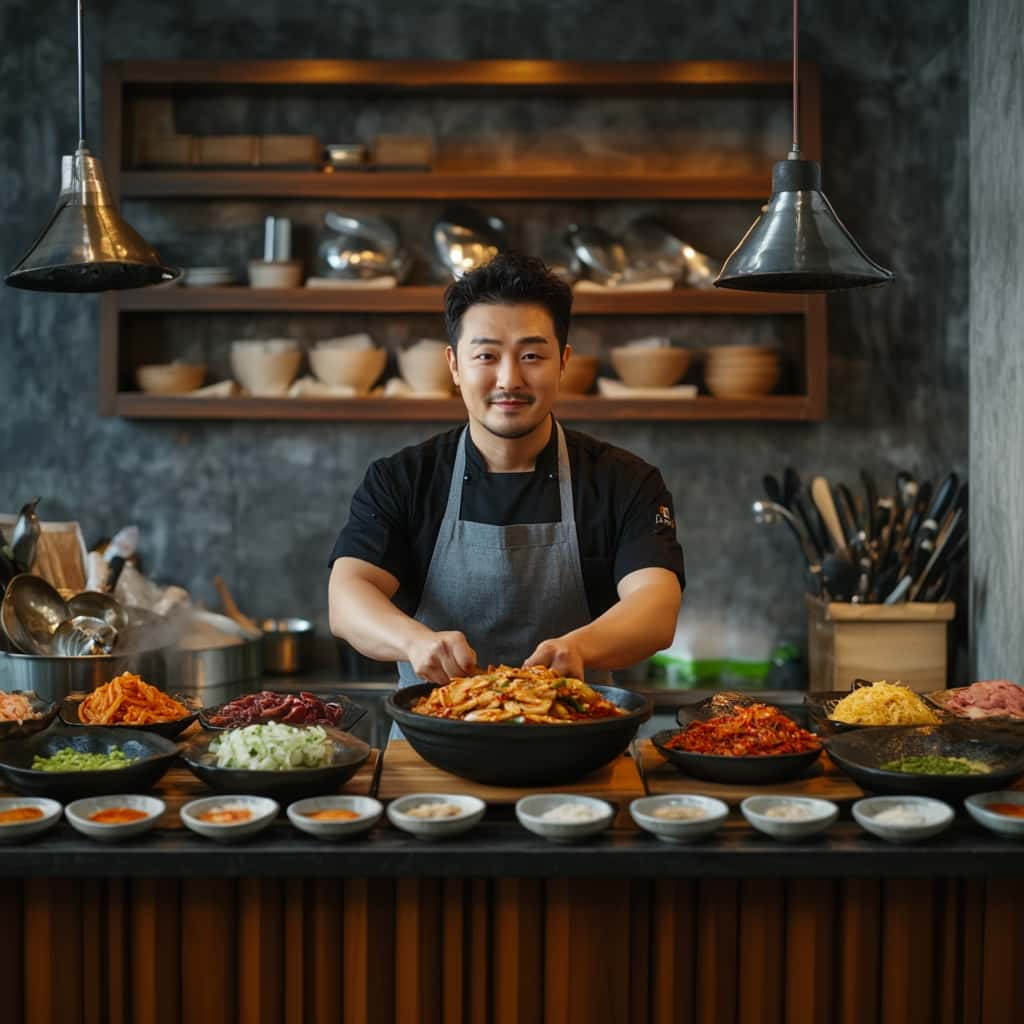Korean Cuisine
Jajangmyeon (Black Bean Sauce Noodles)
Make your taste buds dance with Jajangmyeon, a savory Korean noodle dish that promises an explosion of flavors—discover how to create this culinary delight!
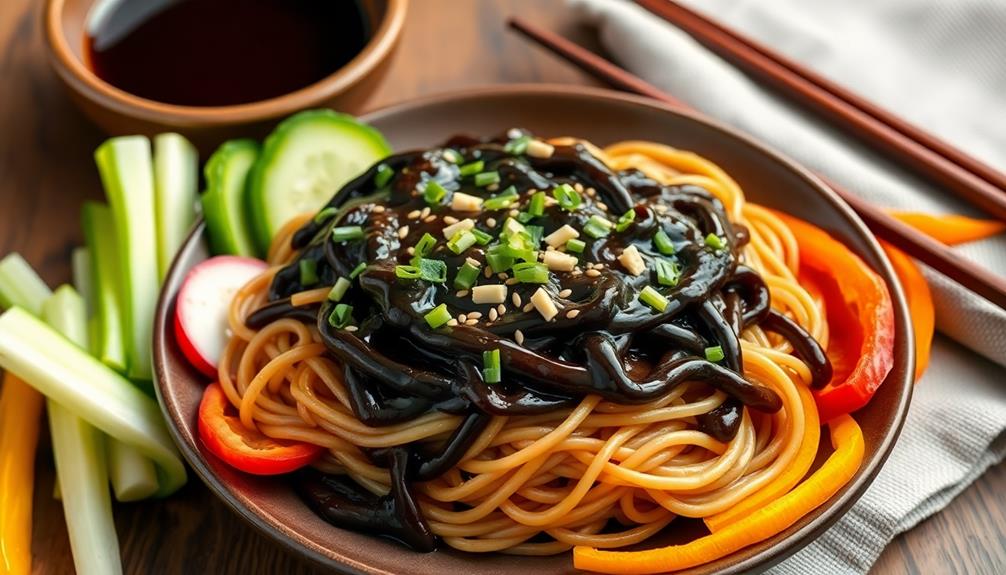
Jajangmyeon, or black bean sauce noodles, is a delicious Korean dish that's super fun to make! You start with chewy noodles and then mix in a savory black bean sauce made from fermented black beans—it's like a flavor party in your mouth! Traditionally enjoyed on special occasions, this comforting meal often features yummy toppings like crunchy cucumbers and even a fried egg for extra creaminess. It's perfect for sharing with family and friends, making mealtime a blast! If you wanna whip up your own delightful bowl of Jajangmyeon, stick around and you'll find all the tasty details!
Key Takeaways
- Jajangmyeon, also known as Black Bean Sauce Noodles, originated from China's Zhajiangmian and was adapted by Korean immigrants in the late 19th century.
- The dish is made with wheat noodles, pork belly (or tofu), mixed vegetables, and a savory black bean paste called chunjang.
- Traditionally enjoyed on Black Day (April 14), Jajangmyeon serves as a comfort food for those without Valentine's gifts.
- Enhancements include toppings like sliced cucumber, fried eggs, and pickled radish, adding flavor and visual appeal to the dish.
- Cooking Jajangmyeon is a communal experience, perfect for family gatherings, reflecting the rich culinary tradition of Korean cuisine.
History
Jajangmyeon, a beloved Korean dish, has a history that dates back to the late 19th century. This tasty meal started in China, where it was known as "Zhajiangmian." When Korean immigrants brought it to Korea, they added their special twist, creating a unique version that everyone loves today! You might find it hard to resist the combination of chewy noodles and savory black bean sauce.
As you dig into a bowl of jajangmyeon, you're not just enjoying a meal; you're also tasting a bit of history. It quickly became popular, especially in cities like Incheon, where many Chinese immigrants settled. Over the years, it transformed into a comfort food for many Koreans, often eaten on special occasions or during family gatherings. Isn't that cool?
You might even hear people say that eating jajangmyeon on Black Day (April 14) is a must, especially for those who didn't receive gifts on Valentine's Day.
Recipe
Jajangmyeon is a popular Korean dish that features thick wheat noodles topped with a savory black bean sauce, made primarily from fermented black soybeans. This comforting dish isn't only delicious but also quite satisfying, making it a favorite among many. For those looking for a variation on the traditional jajangmyeon, they can try making a delicious japchae recipe instead. Japchae is a Korean dish made from sweet potato noodles stir-fried with assorted vegetables and sometimes beef or mushrooms. It’s another popular dish that offers a different flavor profile and texture compared to jajangmyeon, providing a variety of options for those who love Korean cuisine.
The combination of chewy noodles, tender pork or vegetables, and rich, umami-packed sauce creates a delightful experience for the senses. Traditionally, this dish is enjoyed on special occasions, but it's simple enough to be made any day of the week.
To make Jajangmyeon, you'll need to gather some essential ingredients. The star of the dish is the black bean paste, known as chunjang, which provides the distinctive flavor and color. While the dish is often made with pork, you can easily substitute it with chicken, beef, or even tofu for a vegetarian version.
Fresh vegetables not only add texture and nutrients but also help balance the richness of the sauce. Once you have your ingredients ready, you'll be ready to create this delicious noodle dish that's sure to impress.
Ingredients:
- 200g of wheat noodles
- 150g of pork belly (or protein of choice)
- 1 medium onion, diced
- 1 medium zucchini, diced
- 1 medium potato, diced
- 1 cup of cabbage, chopped
- 3 tablespoons of chunjang (Korean black bean paste)
- 2 tablespoons of soy sauce
- 1 tablespoon of sugar
- 2 tablespoons of vegetable oil
- 2 cups of water
- Sesame oil (for drizzling)
- Chopped green onions (for garnish)
To cook Jajangmyeon, start by boiling a pot of water and cooking the wheat noodles according to the package instructions. While the noodles are cooking, heat the vegetable oil in a large pan over medium heat.
Add the diced pork and sauté until it's browned. Incorporate the onion, zucchini, potato, and cabbage, cooking until the vegetables are tender. Push the ingredients to the side of the pan, and add the chunjang, soy sauce, and sugar.
Stir-fry the paste for about 2-3 minutes before adding the water. Let the sauce simmer for about 10 minutes until it thickens slightly. Once the noodles are cooked, drain them, and serve topped with the black bean sauce and a drizzle of sesame oil.
Garnish with chopped green onions.
When preparing Jajangmyeon, remember that chunjang can vary in flavor and saltiness depending on the brand, so feel free to adjust the quantity of soy sauce to taste.
It's also a good idea to prepare all your ingredients before you start cooking, as the process moves quickly once you begin. For an added depth of flavor, consider adding a splash of oyster sauce or a sprinkle of black pepper to the sauce.
Enjoy your homemade Jajangmyeon!
Cooking Steps
Now that you've got your Jajangmyeon recipe ready, it's time to jump into the cooking steps!
First, you'll want to prepare fresh ingredients that make your dish pop with flavor.
After that, cook the noodles al dente, mix them with the sauce, and don't forget to add some tasty toppings before serving with pickled radish for that extra zing!
Step 1. Prepare Fresh Ingredients
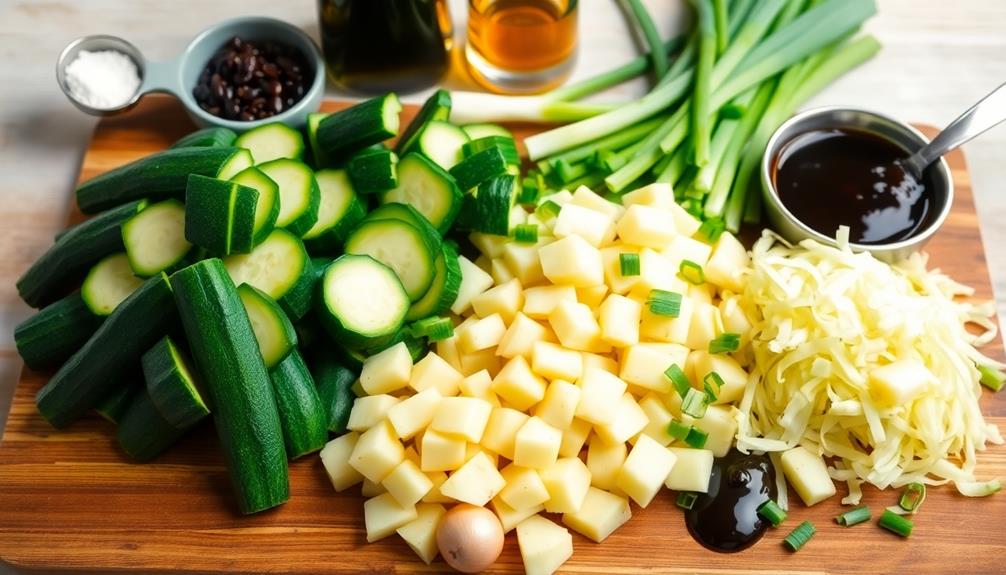
To create a delicious bowl of jajangmyeon, you'll need to gather and prepare fresh ingredients that bring vibrant flavors to the dish.
First, grab some fresh vegetables! You'll want a crunchy cucumber, a few carrots, and maybe some zucchini, too. These will add great texture and color to your noodles.
Next, don't forget the onions! Dicing them brings a sweet flavor that pairs perfectly with the black bean sauce.
Now, let's talk about the star of the show: the black bean paste! You can find it in most grocery stores, and it's what makes jajangmyeon so special. If you like a bit of spice, consider adding some chili paste for that extra kick.
Finally, you'll need your protein! You can use diced pork, chicken, or even tofu for a vegetarian option. Make sure it's cut into small pieces so it cooks evenly.
Once you've got everything prepped, you'll be ready to move on to the next step.
It's like a fun puzzle, putting together all these ingredients to create a tasty masterpiece! Enjoy the process, and get excited about your delicious meal!
Step 2. Cook the Noodles Al Dente
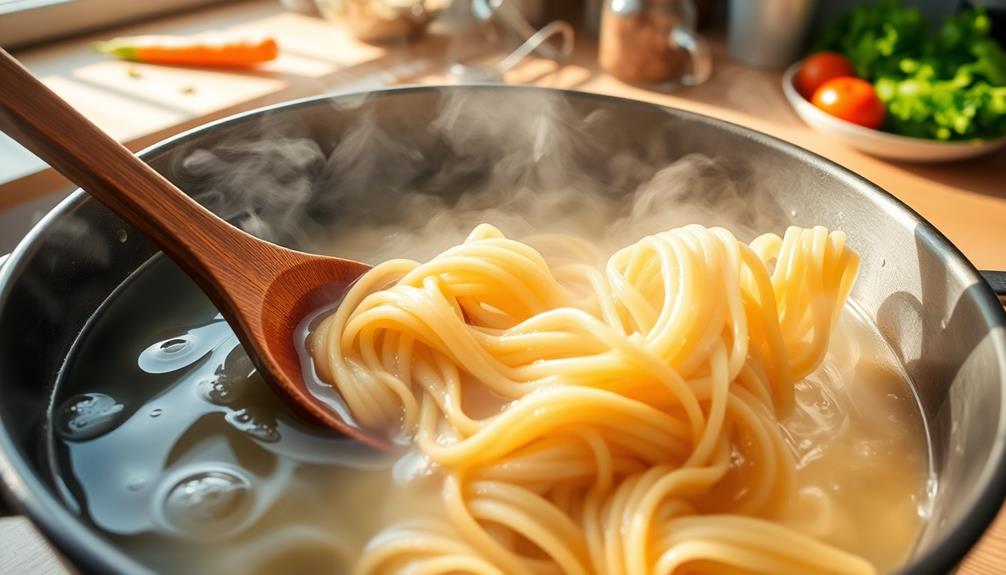
Once you've prepped your ingredients, it's time to cook the noodles to perfection. Start by bringing a large pot of water to a rolling boil. Don't forget to add a pinch of salt—it'll help flavor the noodles!
Once the water is bubbling away, gently toss in your noodles. Be careful not to splash, unless you want a surprise shower!
Now, keep an eye on them as they cook. Most noodles take about 5 to 7 minutes, but you'll want to check the package instructions for the exact time. You're aiming for al dente, which means the noodles should be firm to the bite, not mushy.
Give them a little stir every now and then to prevent sticking, and taste a noodle a minute or two before the time's up. If it's slightly chewy but not hard, you're golden!
Once they're ready, carefully drain the noodles in a colander. Rinse them under cool water for a few seconds to stop the cooking.
Now, they're perfectly cooked, and you're one step closer to enjoying delicious jajangmyeon! Isn't cooking fun?
Step 3. Mix Sauce and Noodles
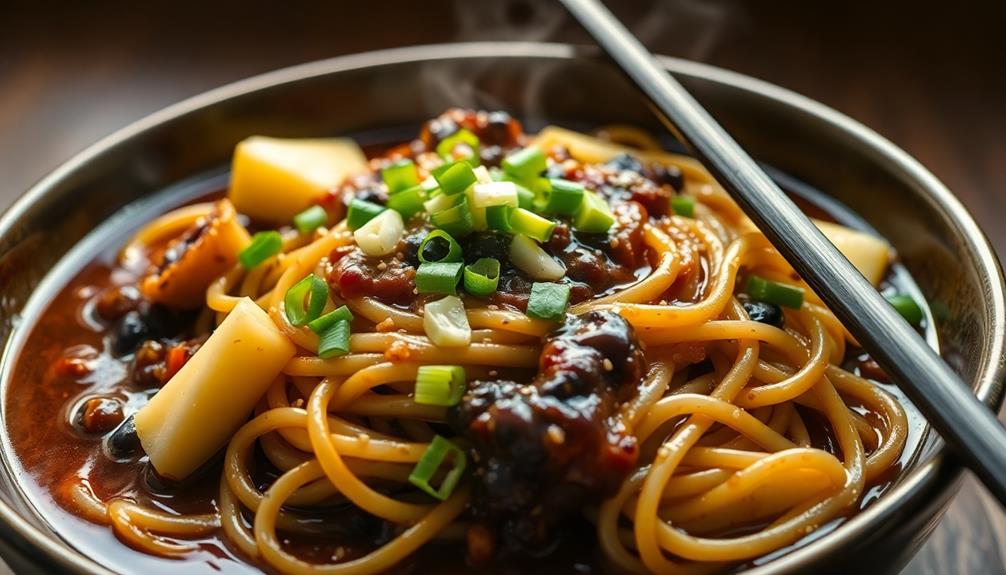
With the noodles perfectly cooked and drained, it's time to bring everything together. Grab that delicious black bean sauce you made earlier, and let's make some magic!
Start by placing the drained noodles in a large mixing bowl. Now, pour the black bean sauce over the noodles, making sure to cover them all. This is where the fun begins!
Using a pair of chopsticks or tongs, gently toss the noodles and sauce together. You want to mix them up well so that every noodle gets a good coating of that rich, savory sauce. It's like giving the noodles a warm, tasty hug!
As you mix, be careful not to break the noodles. You want them to stay long and slurpable. If you find the sauce too thick, you can add a splash of water or broth to help it blend in better.
Keep mixing until the noodles are evenly coated, and the colors look vibrant and inviting. Trust me, your taste buds are already dancing!
Once everything's mixed, take a moment to admire your creation—you're already halfway to a delicious Jajangmyeon feast!
Step 4. Add Toppings and Garnishes
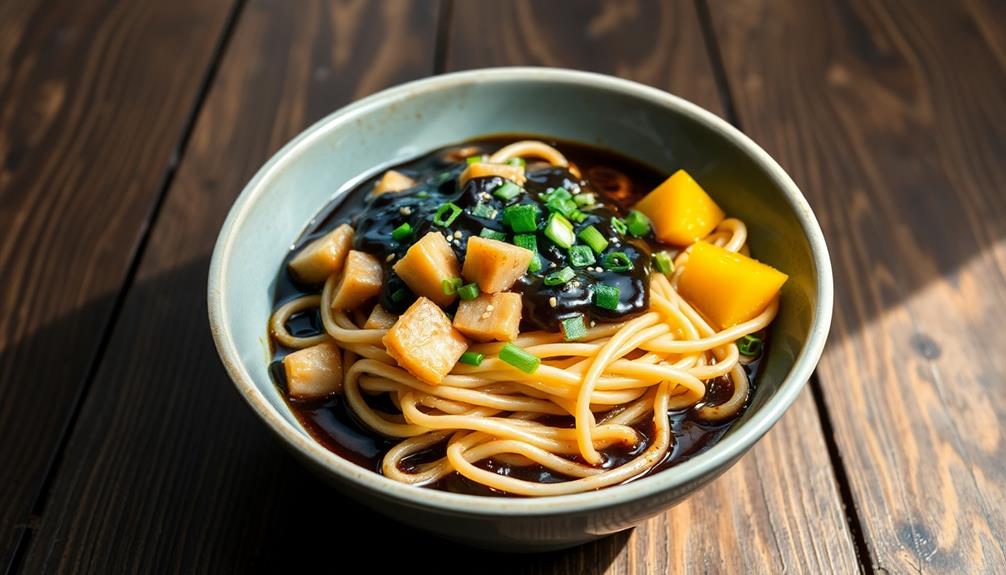
Now that your noodles are coated in that luscious black bean sauce, it's time to pile on the toppings and garnishes that'll elevate your Jajangmyeon to the next level.
First up, grab some fresh cucumber and slice it into thin strips. The crunchiness will add a delightful texture to your dish, making each bite even more exciting! If you're feeling adventurous, toss in some diced radish for a little zing.
Next, don't forget the green onions! Chop a few and sprinkle them generously over the top. They not only add a pop of color but also a fresh flavor that balances the richness of the sauce.
If you like a bit of spice, consider adding sliced chili peppers. Just a few will do—too many, and your taste buds might stage a protest!
Lastly, for the finishing touch, why not add a fried egg on top? The runny yolk mixes beautifully with the noodles and sauce, creating a creamy delight.
With all these toppings, your Jajangmyeon will look as good as it tastes. Dig in and enjoy your masterpiece!
Step 5. Serve With Pickled Radish

To enhance your Jajangmyeon experience, serve it alongside pickled radish, which adds a refreshing contrast to the rich flavors of the dish. You can easily make pickled radish at home! Just grab some Korean radish, slice it into thin strips or small cubes, and sprinkle a bit of salt on top. Let it sit for about 30 minutes to draw out some moisture.
Next, mix together a simple brine using equal parts vinegar and sugar, along with a dash of water to balance the flavors. Stir until the sugar dissolves completely.
Once your radish has released some water, rinse it lightly and then toss it into the brine. Let it soak for at least an hour in the refrigerator, or overnight for an even stronger flavor.
When you're ready to eat, serve the pickled radish in a small bowl next to your Jajangmyeon. The crunchy, tangy bites make each slurp of noodles even more delightful!
Plus, you'll impress your friends with this tasty side. So go ahead, dig in, and enjoy the delightful combination of flavors on your plate!
Final Thoughts
Jajangmyeon stands out as more than just a meal; it's a culinary experience that connects you to Korean culture and tradition.
When you dive into a bowl of these delicious black bean sauce noodles, you're not just tasting food; you're savoring a rich history that many enjoy.
Each bite is a blend of flavors: the savory black bean sauce, tender noodles, and crunchy vegetables all come together to make your taste buds dance!
Making jajangmyeon at home can be a fun adventure.
You can gather your family and friends, chop up some veggies, and stir up that glossy sauce.
It's a great way to bond, and who knows? You might even discover your hidden chef skills!
Plus, serving it with pickled radish adds that perfect crunch.
Frequently Asked Questions
What Are the Origins of Jajangmyeon Outside of Korea?
You'll find that dishes similar to jajangmyeon have roots in Chinese cuisine, particularly in regions with significant Chinese immigrant communities. These adaptations often reflect local tastes, blending traditional flavors with regional ingredients and preferences.
Can Jajangmyeon Be Made Vegan-Friendly?
Yes, you can definitely make it vegan-friendly! Substitute traditional ingredients with plant-based alternatives like tofu instead of meat, and use vegetable broth and soy sauce to create a delicious, cruelty-free version. Enjoy your meal!
What Are Common Side Dishes Served With Jajangmyeon?
When enjoying a meal, you might pair it with common side dishes like pickled radish, kimchi, or stir-fried vegetables. These complement the main dish, enhancing flavors and providing a balanced dining experience.
How Do You Properly Store Leftover Jajangmyeon?
To properly store leftovers, place them in an airtight container and refrigerate. They'll stay fresh for up to three days. When you're ready to eat, reheat gently on the stove or microwave. Enjoy!
Are There Any Health Benefits Associated With Jajangmyeon?
You might find some health benefits in dishes like this, as they often include vegetables and protein. The fiber can aid digestion, and the sauce may provide antioxidants, depending on the ingredients used. Enjoy in moderation!
Ji-hoon is a skilled chef specializing in traditional and modern Korean cuisine. From savory bulgogi and kimchi to hearty stews and sizzling bibimbap, Ji-hoon’s recipes bring Korea’s bold, spicy, and umami-rich flavors to your kitchen. He focuses on authentic techniques and fresh ingredients that make Korean food so vibrant and flavorful.
Korean Cuisine
Osam Bulgogi: Korean Stir-Fried Squid and Pork Belly
Taste the irresistible combination of tender squid and crispy pork belly in Osam Bulgogi, and discover the secrets to this delightful Korean dish!

Osam Bulgogi is an exciting Korean dish that features tender squid and crispy pork belly! For a yummy experience, you'll slice the pork belly thin and marinate the squid in a tasty sauce made from soy sauce, garlic, and sesame oil. Then, toss in some colorful vegetables for a nice crunch. Stir-fry everything over high heat until it's perfectly cooked and finish it off with a drizzle of sesame oil. This dish isn't just delicious; it's all about sharing and having fun together! If you're curious about more tips and tasty twists, keep on exploring!
Key Takeaways
- Osam Bulgogi is a Korean dish combining stir-fried squid and pork belly, originating from coastal regions.
- The dish features a spicy and savory marinade made with gochujang, soy sauce, and garlic.
- Preparation involves cleaning and marinating squid, slicing pork belly, and chopping vegetables like onions and bell peppers.
- Cooking includes rendering pork fat, adding squid and vegetables, and stir-frying quickly to maintain texture.
- Osam Bulgogi is often served with steamed rice, kimchi, and can be customized with favorite vegetables and spice levels.
History
The history of Osam Bulgogi reveals a delightful blend of culinary traditions that reflect Korea's rich maritime culture. This tasty dish combines two popular ingredients: squid and pork belly.
You might wonder how it became a favorite among many. Well, it all started in coastal regions of Korea, where fresh seafood was abundant. Fishermen would catch squid, and local families would often cook it in various ways. Over time, they decided to mix this delicious seafood with pork belly, a meat that many loved for its rich flavor.
As people shared their cooking secrets, this unique combination grew in popularity. The spicy and savory sauce, made with gochujang, soy sauce, and garlic, added a wonderful kick, making Osam Bulgogi even more special.
It wasn't just a meal; it became a way for families and friends to gather and enjoy each other's company. Today, you can find this dish at many Korean restaurants, where it's cooked right in front of you, creating a fun dining experience.
Cooking Steps
To get started on making Osam Bulgogi, gather your ingredients and prep everything before diving into the cooking process. You'll need squid, pork belly, onion, green peppers, and some tasty seasonings like gochujang and soy sauce.
Once you have everything ready, slice the pork belly and squid into bite-sized pieces.
Next, heat a large pan over medium-high heat. Add the pork belly first, cooking until it's crispy and golden. This will give your dish a delicious flavor!
After that, toss in the onion and green peppers, stirring them around for a few minutes until they're soft and fragrant.
Now it's time to add the squid! Since it cooks quickly, stir-fry it just until it turns opaque.
Then, pour in your gochujang, soy sauce, and any other seasonings you like. Mix everything well, letting the flavors blend together.
Once everything's cooked through, take a moment to admire your creation. Serve Osam Bulgogi hot, and enjoy it with rice or lettuce wraps.
You'll love how colorful and tasty this dish is! Happy cooking!
Step 1. Slice Pork Belly Thinly

Start by placing the pork belly in the freezer for about 30 minutes; this makes it easier to slice.
Once it's nice and firm, take it out and grab a sharp knife. A sharp knife is super important because it helps you cut through the meat smoothly.
Now, place the pork belly on a cutting board. You want to slice it thinly, so aim for about a quarter-inch thick. It might help to angle your knife a little, guiding it through the meat.
As you slice, you'll notice the beautiful layers of fat and meat, which will add so much flavor later!
Don't rush this part; take your time to make even slices. If you notice any uneven pieces, just trim them up a bit.
Once you've sliced the entire pork belly, you can gather the pieces and set them aside.
It's okay if they're not perfect—what matters is that they're thin enough to cook quickly and soak up all the yummy flavors later on.
You're doing great, and soon, you'll be ready to move on to the next fun step in making your Osam Bulgogi!
Step 2. Marinate Squid in Sauce
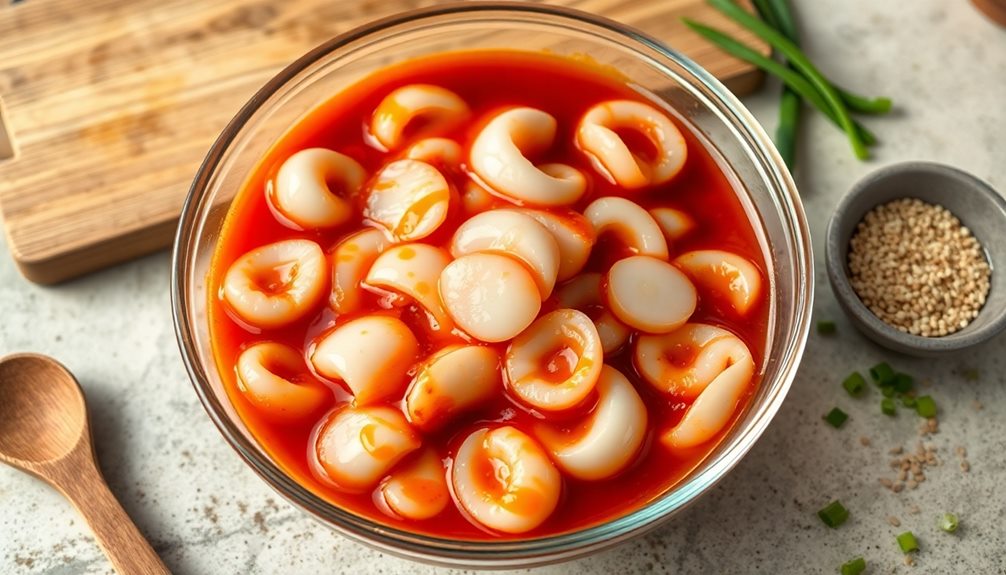
With the pork belly sliced and ready, it's time to give the squid a flavorful marinade.
Start by rinsing your squid under cold water to make sure it's fresh and clean. Then, cut the squid into bite-sized pieces. You want them to be easy to eat, so aim for about an inch long.
Now, let's whip up that marinade! In a bowl, mix together some soy sauce, garlic, and a splash of sesame oil. This combination gives the squid a delicious taste. Add a pinch of sugar for a touch of sweetness and a bit of red pepper flakes if you like it spicy.
Once your marinade is ready, toss the squid pieces into the bowl, making sure each piece gets coated in that yummy sauce.
Let the squid sit and soak up all those flavors for about 15 to 30 minutes. This step is super important because it makes the squid extra tasty when you cook it later.
Now that you've marinated your squid, you're one step closer to making a delightful Osam Bulgogi. Exciting, right?
Step 3. Add Vegetables for Crunch
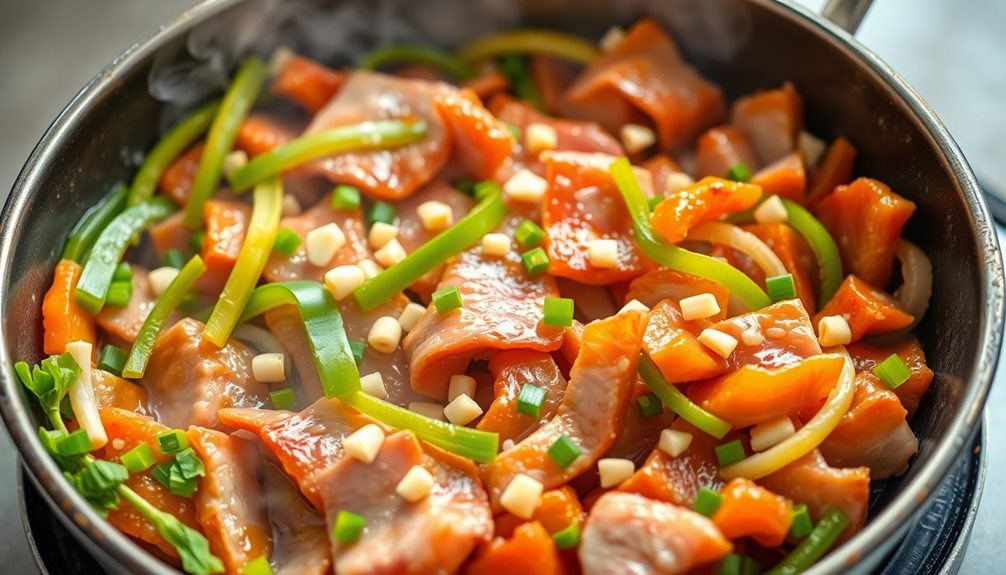
Adding vegetables to your Osam Bulgogi not only enhances the dish's flavor but also provides a satisfying crunch. To get started, gather some colorful veggies like bell peppers, carrots, and green onions. These won't only look great in your dish but also add a burst of freshness.
First, wash and slice your vegetables into bite-sized pieces. You want them to cook quickly and evenly, so think about how they'll mix with the squid and pork belly.
Once your squid and pork belly are marinated and ready to go, you can add the veggies to the pan. Toss them in gently, mixing everything together.
As the vegetables cook, they'll start to soften a bit while still keeping that delightful crunch. This is when your kitchen will start to smell amazing!
Keep an eye on the colors; you want them vibrant and lively, which shows they're cooked just right.
Step 4. Stir-Fry Over High Heat
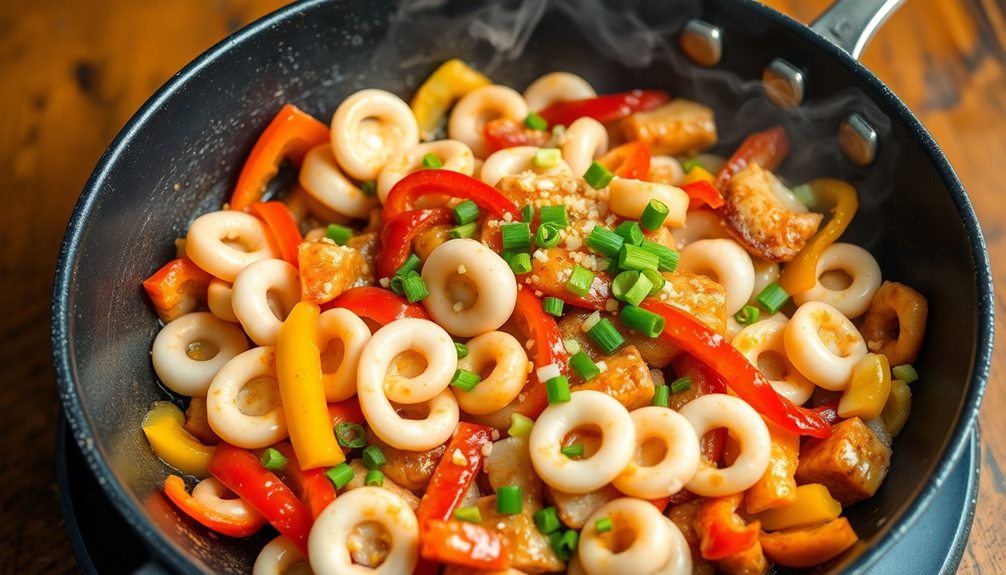
How do you achieve that perfect stir-fry for your Osam Bulgogi? First, it's all about the heat! You want your pan or wok to be super hot. This helps cook the squid and pork belly quickly, giving them a nice, crispy edge.
Start by adding a splash of oil, then toss in your marinated pork belly. Let it sizzle for a few minutes until it's golden brown. Don't forget to stir!
Next, add the squid. Stir-fry it for just a couple of minutes. Squid cooks fast, and you don't want it to be rubbery. Keep everything moving in the pan; that's the secret to great stir-frying! If you notice things sticking, add a bit more oil, but don't drown it.
After the squid is cooked, toss in your crunchy vegetables from the previous step. Give it all a good mix for another minute or two. The colors should pop, and the smells will make your mouth water!
Your Osam Bulgogi is almost ready, with each ingredient perfectly cooked, all thanks to that high heat. Enjoy the fun of stir-frying, and get ready for the delicious flavors to come!
Step 5. Add Sesame Oil Drizzle

Drizzling sesame oil over your Osam Bulgogi elevates its flavor profile and adds a nutty aroma that perfectly complements the dish. Once your squid and pork belly are cooked to perfection, it's time to add that special touch! Grab your bottle of sesame oil, and get ready to make your meal even more delicious.
After you've finished stir-frying, take a moment to admire your vibrant dish. Now, pour about one to two teaspoons of sesame oil evenly over the top. This isn't just for flavor; it creates a shiny finish that makes your Osam Bulgogi look amazing!
Next, gently toss the dish with your spatula to ensure every piece gets coated in that lovely oil. This step is super important, as it helps the flavors blend together beautifully.
If you'd like, sprinkle a few sesame seeds on top for extra crunch and a beautiful presentation.
Final Thoughts
Ultimately, enjoying Osam Bulgogi is about embracing the vibrant flavors and textures that come together in this dish. When you take a bite, you'll discover the tender squid and juicy pork belly dancing together, creating a symphony of taste. The spicy gochugaru and savory soy sauce bring everything to life, making your taste buds sing with joy.
As you prepare this dish, remember it's all about sharing the fun! Cooking Osam Bulgogi can be a great activity with family or friends. You can laugh, chat, and enjoy the process together.
Once it's ready, gather everyone around the table. The delicious aroma will draw them in, and they'll be excited to dig in!
Don't forget, you can customize your Osam Bulgogi by adding your favorite vegetables or adjusting the spice level. This way, you can make it just how you like it.
Frequently Asked Questions
What Is the Origin of Osam Bulgogi?
You'll find that osam bulgogi originates from Korea, where it's a popular dish combining squid and pork. Its roots trace back to traditional Korean cuisine, emphasizing bold flavors and communal dining experiences.
Can I Use Alternative Proteins for Osam Bulgogi?
Absolutely, you can use alternative proteins! Try chicken, tofu, or tempeh for a delicious twist. Just adjust the cooking time accordingly, and you'll still enjoy a flavorful, satisfying dish that captures the essence of the original.
What Side Dishes Pair Well With Osam Bulgogi?
When you're enjoying a flavorful dish, consider pairing it with kimchi, pickled vegetables, or steamed rice. These sides complement the rich flavors, balancing the meal and enhancing your overall dining experience. Enjoy your meal!
How Spicy Is Traditional Osam Bulgogi?
Traditional dishes can vary in spice, but you'll often find osam bulgogi has a medium to high heat level. It's seasoned with gochujang and other spices, so be prepared for a flavorful kick!
Where Can I Find Osam Bulgogi in Restaurants?
You can find osam bulgogi in Korean restaurants, especially those specializing in barbecue or stir-fry dishes. Check local reviews or food apps to discover popular spots that serve this delicious and spicy dish.
Ji-hoon is a skilled chef specializing in traditional and modern Korean cuisine. From savory bulgogi and kimchi to hearty stews and sizzling bibimbap, Ji-hoon’s recipes bring Korea’s bold, spicy, and umami-rich flavors to your kitchen. He focuses on authentic techniques and fresh ingredients that make Korean food so vibrant and flavorful.
Korean Cuisine
Dubu Kimchi: The Perfect Korean Tofu and Kimchi Combo
Savor the harmonious blend of silky tofu and bold, tangy kimchi in this beloved Korean comfort food dish that’s packed with layers of flavor.

Dubu kimchi is the perfect Korean comfort food, blending silky tofu with the bold, tangy flavors of spicy kimchi. This beloved dish has roots tracing back to ancient Korean kingdoms, evolving over centuries to showcase regional traditions. To make it, you'll start by thoroughly draining and pressing the tofu to capture its texture. Then, you'll sauté aromatic garlic and onions as a flavorful base, before adding the vibrant kimchi. Finally, the tofu and kimchi mingle together, creating a harmonious balance of flavors and textures. Sprinkle toasted sesame seeds on top for the perfect finishing touch. Experience the captivating culinary delight that is dubu kimchi.
Key Takeaways
- Dubu kimchi is a beloved Korean dish that combines silky tofu with spicy, fermented kimchi, creating a comforting and flavorful experience.
- The dish has a rich history, originating from ancient Korean kingdoms and evolving over centuries to showcase regional culinary traditions.
- Preparing dubu kimchi involves carefully draining and pressing tofu, sautéing aromatics, and seamlessly integrating the kimchi to achieve a harmonious balance of flavors.
- The dish is versatile, serving as both a side dish and a main course, and represents the enduring legacy of traditional Korean culinary practices.
- Garnishing dubu kimchi with toasted sesame seeds adds a delightful nutty accent, enhancing the overall sensory experience of this unique Korean specialty.
History
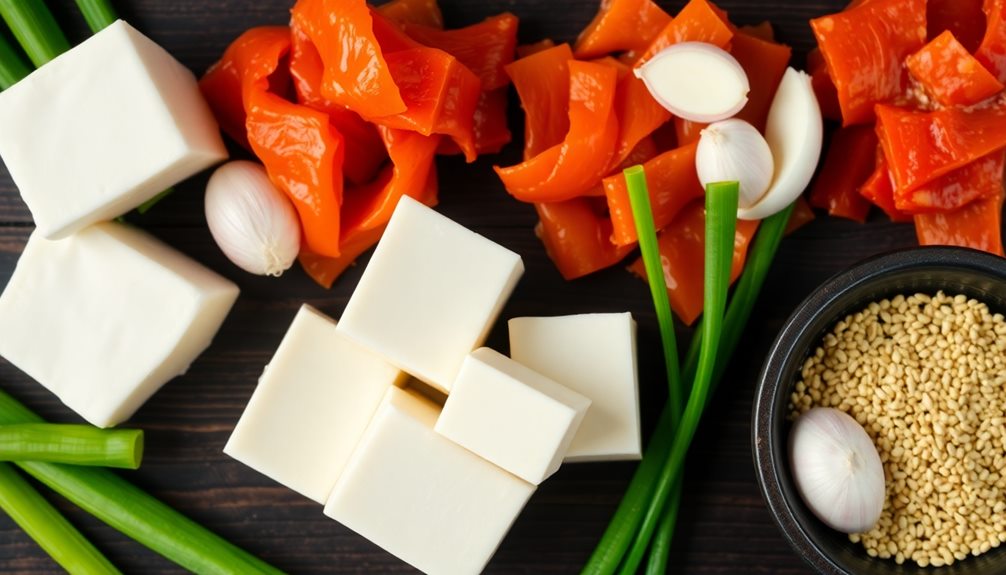
Dubu kimchi, the beloved Korean dish, has a rich history that dates back centuries. This iconic combination of silky tofu and spicy, fermented kimchi has been a staple in Korean cuisine for generations.
The origin of dubu kimchi can be traced to the ancient Korean kingdoms, where it was enjoyed as a nutritious and flavorful side dish. Over time, the recipe and preparation methods have evolved, reflecting the culinary traditions and regional variations across the Korean peninsula.
Today, dubu kimchi remains a beloved comfort food, cherished for its perfect balance of textures and flavors. Whether served as a main course or alongside other Korean dishes, this beloved dish continues to bring joy and satisfaction to those who savor its delicious simplicity.
The story of dubu kimchi is a testament to the enduring power of traditional Korean cuisine to nourish both body and soul.
Cooking Steps
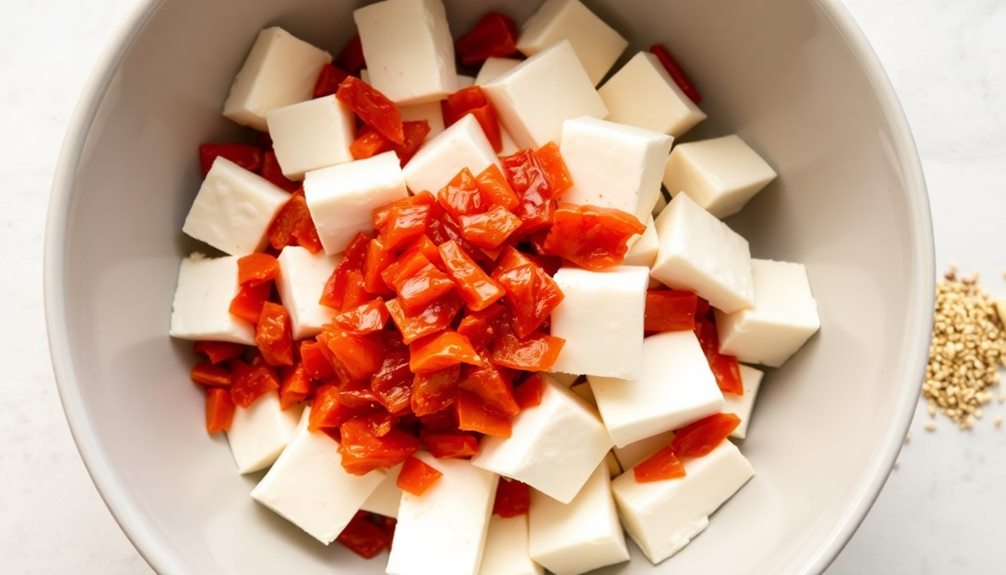
Preparing the essential ingredients is the initial step in crafting the flavorful Dubu Kimchi dish. First, you'll need to gather firm tofu, crunchy kimchi, and a few other tasty add-ins.
Slice the tofu into bite-sized cubes, taking care not to make them too thin. Next, chop the kimchi into smaller pieces, ensuring a perfect bite in every mouthful.
Now, it's time to mix things up! In a large bowl, combine the tofu and kimchi. Drizzle in a bit of the flavorful kimchi juice, giving everything a gentle stir.
Don't forget to season with a sprinkle of sugar and a dash of soy sauce – this will enhance the savory-sweet balance.
With the prep work done, the final step is to transfer the Dubu Kimchi mixture to a serving dish. Garnish it with sliced green onions and a sprinkle of sesame seeds for a vibrant, appetizing presentation.
Get ready to indulge in the perfect harmony of soft tofu and tangy kimchi!
Step 1. Drain and Press Tofu Thoroughly
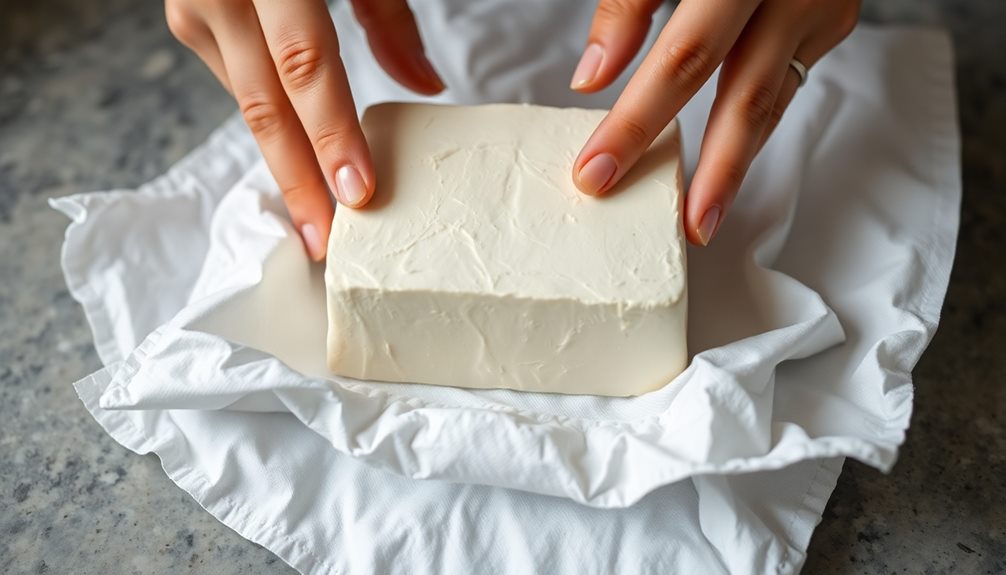
Before you can begin assembling the dish, it's crucial to properly drain and press the tofu. This crucial step ensures your Dubu Kimchi has the perfect texture.
First, remove the tofu from its packaging and gently pat it dry with paper towels. Next, place the tofu block between two clean, absorbent towels or paper towels.
Apply firm pressure, slowly pressing down to squeeze out as much liquid as possible. You may need to replace the towels a few times to get the tofu as dry as can be.
Once it's nice and firm, you're ready to cut it into bite-sized cubes. Thoroughly drained and pressed tofu will soak up all the delicious flavors of the kimchi, creating a harmonious blend of textures and tastes in every bite.
Don't skip this essential preparation – it's the key to unlocking the full potential of your Dubu Kimchi!
Step 2. Sauté Garlic and Onions
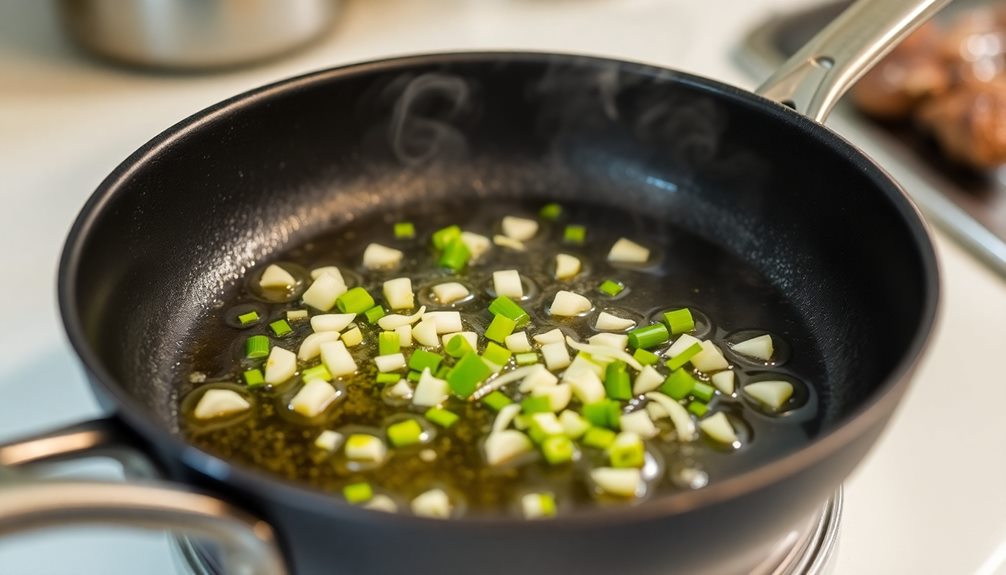
Next, sauté the garlic and onions. Heat a large skillet or wok over medium heat and add a bit of oil.
Once it's hot, toss in the minced garlic and diced onions. Stir them around, letting the aroma fill your kitchen. The onions will start to soften and turn translucent, and the garlic will become fragrant.
This step is crucial as it creates a flavorful base that enhances the overall dish, similar to how a well-planned budget sets the stage for financial success.
Keep an eye on them, making sure they don't burn. You want them to cook until they're nice and tender, about 5-7 minutes. Stir frequently to prevent sticking.
The garlic and onions create a flavorful base for the rest of the dish. Their sweetness will complement the kimchi perfectly.
Once they're ready, you can move on to the next step. Get ready to add the tofu and kimchi – this is where the magic really happens!
Step 3. Add Kimchi to Pan
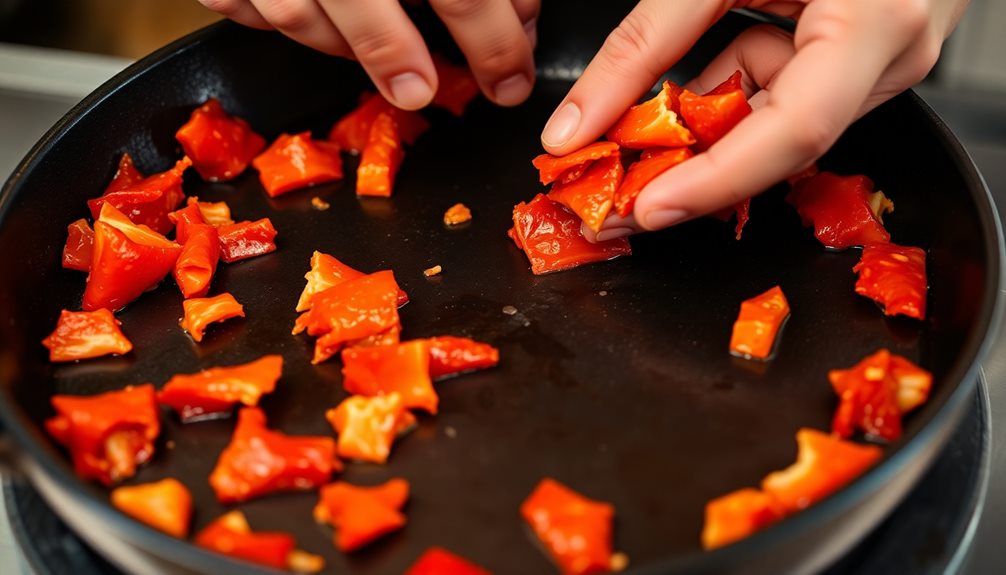
After sautéing the garlic and onions, add the kimchi to the pan. The tangy, crunchy kimchi will sizzle and release its bold flavors into the mix.
Stir it up quickly to coat the vegetables evenly. This step is all about layering the tastes and textures – the savory garlic, the sweet onions, and the punchy kimchi.
As the kimchi heats up, it'll start to soften a bit, but you still want it to maintain some of its signature crunch. Keep the heat medium-high and let the flavors meld together for about 2-3 minutes.
This is where the magic really starts to happen! The kimchi will infuse the entire dish with its bright, spicy personality. Get ready for an explosion of flavor in your mouth.
Once everything is nicely combined, you're ready to move on to the next step. Don't be afraid to adjust the seasoning at this point if needed.
Step 4. Combine Tofu and Kimchi Mixture
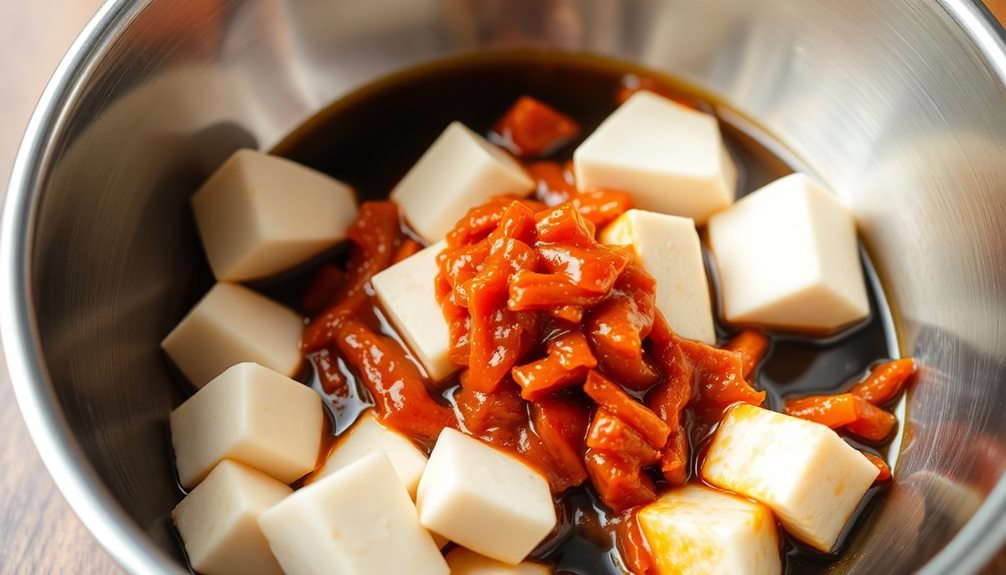
With the vibrant kimchi sizzling away, it's time to incorporate the tofu into the mix. Grab that block of fresh tofu and give it a gentle pat to remove any excess moisture.
Now, slice it into bite-sized cubes, careful not to break them apart. Toss the tofu cubes right into the pan with the sizzling kimchi. Give everything a good stir, making sure the tofu is fully coated in the flavorful juices.
As the tofu and kimchi mingle, you'll notice the vibrant colors blending together, creating a mouthwatering sight. Let the mixture cook for a few minutes, allowing the tofu to soak up all the bold, tangy flavors of the kimchi.
Stir occasionally to prevent sticking. The tofu should take on a slightly golden hue as it warms through. Once everything is heated and well combined, you're ready to serve up this delightful Korean dish.
Get ready for a flavor explosion in every bite!
Step 5. Garnish With Sesame Seeds
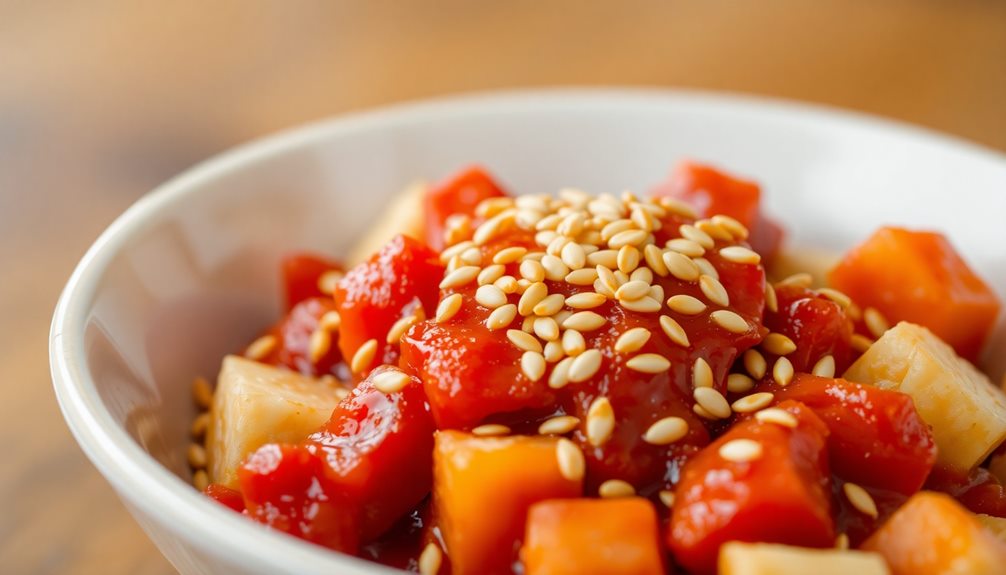
As the tofu and kimchi come together in a vibrant dance of flavors, it's time to add the finishing touch. Sprinkle a generous amount of toasted sesame seeds over the top of your dish.
These crunchy little seeds not only add a wonderful nutty taste, but they also provide a beautiful visual contrast to the deep greens of the kimchi.
Gently press the sesame seeds into the mixture, ensuring they adhere to the tofu and kimchi. The sesame seeds will create a delightful crunch with every bite, complementing the soft, silky texture of the tofu. Their rich, earthy flavor will also enhance the spicy, tangy notes of the kimchi, creating a harmonious balance of tastes.
To add even more dimension, you can lightly toast the sesame seeds before sprinkling them over the dish. This simple step intensifies their aroma and brings out their natural oils, making them even more flavorful and irresistible.
Final Thoughts

Dubu kimchi, a harmonious blend of soft tofu and spicy, fermented cabbage, is a culinary delight that leaves a lasting impression.
This beloved Korean dish offers a symphony of flavors and textures that tantalize the senses. The silky smooth tofu provides a perfect canvas for the bold, tangy notes of the kimchi, creating a delightful balance.
As you savor each bite, you'll be captivated by the interplay of the cool, creamy tofu and the fiery, crunchy cabbage.
Whether enjoyed as a side dish or a main course, dubu kimchi is a true celebration of Korean cuisine.
So, the next time you have the chance to try this authentic and satisfying dish, don't hesitate – dive in and experience the magic for yourself!
With its irresistible combination of flavors and textures, dubu kimchi is sure to become a new favorite in your culinary repertoire.
Frequently Asked Questions
Is Dubu Kimchi Suitable for Vegetarians or Vegans?
Yes, dubu kimchi is suitable for vegetarians and vegans. The dish is made with tofu and kimchi, both of which are plant-based ingredients, making it a great option for those following a vegetarian or vegan diet.
How Long Does Dubu Kimchi Last in the Refrigerator?
Properly stored, dubu kimchi can last 3-5 days in the fridge. Keep it sealed in an airtight container and consume it within that timeframe for the best quality and freshness.
Can I Use Different Types of Tofu for Dubu Kimchi?
You can absolutely use different types of tofu for dubu kimchi. Firm, extra-firm, or even silken tofu will work great in this dish. Just choose the texture you prefer and adjust the cooking time accordingly.
What Are Some Alternative Ways to Serve Dubu Kimchi?
You can serve dubu kimchi in various ways beyond the traditional dish. Try it as a topping for rice bowls, stuffed into lettuce wraps, or even tossed with noodles for a quick and flavorful meal.
Is There a Way to Make Dubu Kimchi Less Spicy?
You can make dubu kimchi less spicy by using a milder kimchi or by adding more tofu to the dish. You can also balance the spice with other ingredients like soy sauce, sesame oil, or green onions.
Ji-hoon is a skilled chef specializing in traditional and modern Korean cuisine. From savory bulgogi and kimchi to hearty stews and sizzling bibimbap, Ji-hoon’s recipes bring Korea’s bold, spicy, and umami-rich flavors to your kitchen. He focuses on authentic techniques and fresh ingredients that make Korean food so vibrant and flavorful.
Korean Cuisine
Injeolmi: the Chewy Korean Rice Cake With Nutty Flavors
Taste the delightful chewiness of Injeolmi, the nutty Korean rice cake, and uncover the secrets behind this beloved dessert. You won’t want to miss it!
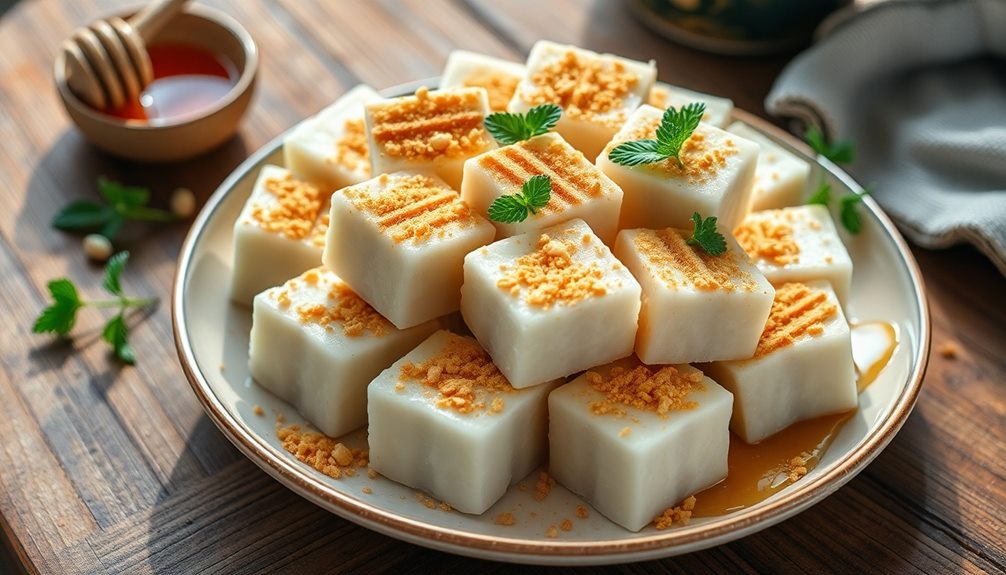
Injeolmi is a tasty Korean rice cake that you're sure to enjoy! It's made from glutinous rice, giving it that delightful chewy texture you can't resist. The nutty flavor comes from being coated in powdered soybean flour, adding a special twist. Traditionally, people enjoy it during celebrations, symbolizing good fortune and togetherness with loved ones. Making Injeolmi can be a fun family activity too, where you can get creative with different toppings and fillings, like sweet red bean paste. It's perfect for sharing during parties and can be paired with tea for an even better treat. Discover more about this unique dessert!
Key Takeaways
- Injeolmi is a traditional Korean rice cake made from glutinous rice, known for its chewy texture and nutty flavor from soybean flour.
- Originating from the Goryeo Dynasty, Injeolmi is associated with good fortune and is commonly served during celebrations and family gatherings.
- The preparation involves soaking, steaming, pounding the rice, filling with red bean paste, and dusting with soybean flour.
- Injeolmi's unique flavor and texture make it an ideal treat for sharing during social occasions, enhancing communal enjoyment.
- It can be enjoyed plain or with various fillings and is often paired with tea for a complete experience.
History
Injeolmi, a traditional Korean rice cake, has a history that spans centuries, with roots tracing back to the Goryeo Dynasty (918-1392). Imagine people back then, enjoying this chewy treat during special celebrations and festivals!
Injeolmi was made from glutinous rice, which is sticky and perfect for creating a delightful texture. Over time, this rice cake became a staple in Korean culture, loved for its nutty flavor and delightful chewiness.
As you explore its history, you'll find that Injeolmi is often associated with good fortune and happiness. Families would make it to celebrate important events, like weddings or the birth of a child. The cake is often coated in powdered soybean flour, giving it that unique taste you might recognize.
Today, Injeolmi is still cherished, not just in Korea but around the world. People enjoy it during holidays and family gatherings, keeping traditions alive.
Whether you've tasted it before or are just learning about it, there's something special about this rice cake that connects generations. So next time you see Injeolmi, remember it's not just a treat; it's a piece of history, bringing joy to many!
Cooking Steps
To make this delicious chewy rice cake, you'll need to start by preparing the ingredients. Gather sweet rice flour, water, and sugar. You'll also want some soybean flour and a pinch of salt for that nutty flavor.
First, mix the sweet rice flour with water in a bowl until it's smooth. Pour this mixture into a steaming dish and steam it for about 20-30 minutes, or until it's cooked through.
While it's steaming, you can prepare the soybean flour by mixing it with sugar and salt in another bowl.
Once the rice cake is ready, let it cool for a bit. Then, you'll want to take it out of the dish and cut it into bite-sized pieces. Roll each piece in the soybean flour mixture, making sure every side is coated. This gives your injeolmi that delightful nutty taste!
Now, it's time to enjoy your chewy rice cake! You can share it with friends or keep it all to yourself—no judgment here!
Just remember, injeolmi is best enjoyed fresh, so dig in while it's still soft and warm. Enjoy your tasty treat!
Step 1. Soak Glutinous Rice Overnight
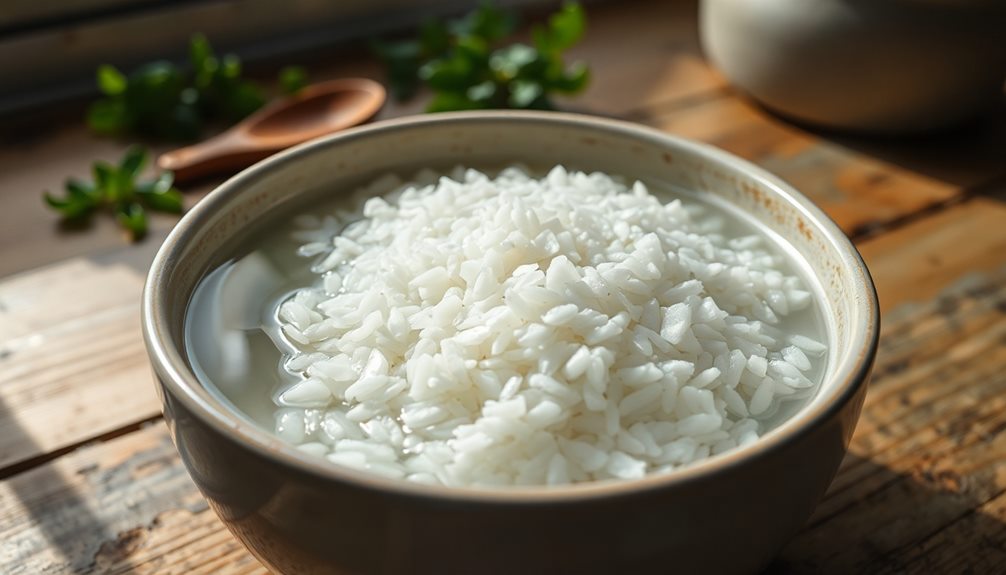
Before you start making your chewy Korean rice cake, soaking the glutinous rice overnight is crucial for achieving the right texture. This step might seem simple, but it's super important! By soaking the rice, you allow it to absorb water and soften, which helps it become that delightful chewy consistency we all love.
To begin, measure out the glutinous rice you need for your recipe. It's usually about two cups, but feel free to adjust based on how much rice cake you want to make. Rinse the rice under cold water in a fine mesh strainer to remove any excess starch. This helps prevent the rice from becoming too sticky.
Next, place the rinsed rice in a large bowl and cover it with enough water, making sure it's submerged.
Now, let the rice soak for at least six to eight hours, or even overnight. This is the perfect time to dream about the delicious injeolmi you'll be making! When you wake up the next day, you'll find the rice plump and ready for the next steps.
Get excited, because you're one step closer to enjoying this tasty treat!
Step 2. Steam the Soaked Rice
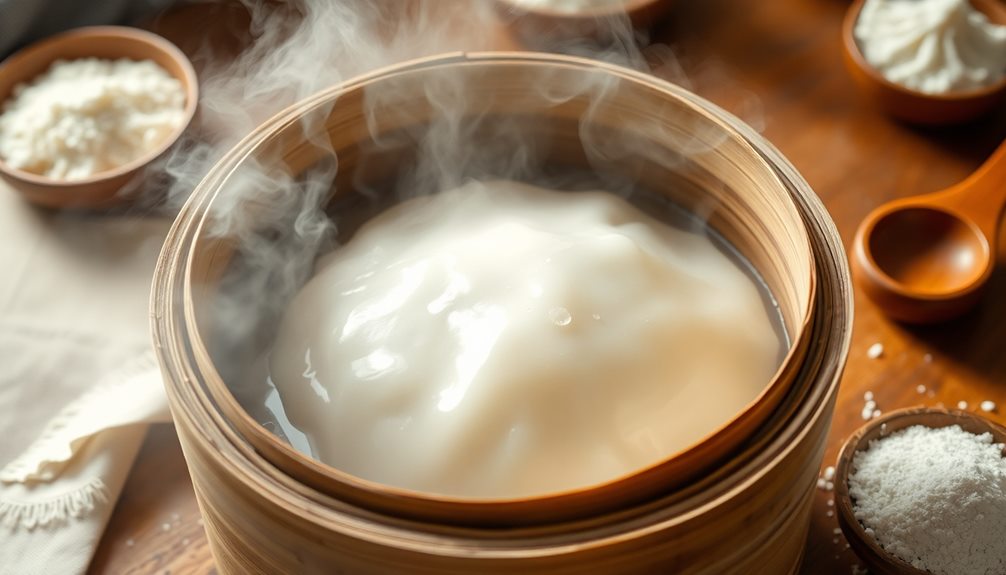
Once the rice has soaked and plumped up, it's time to steam it to achieve that perfect chewy texture. First, grab a steaming basket or a heatproof plate that fits snugly in your pot. You'll want to line it with a clean cheesecloth or a damp paper towel to prevent sticking.
Now, take your soaked rice and spread it evenly in the basket. Don't worry if it looks a bit lumpy; it'll all come together soon!
Next, fill your pot with water, making sure it doesn't touch the rice. Bring the water to a gentle boil, then carefully place your steaming basket over the pot. Cover it with a lid to keep all that steam inside.
Steam the rice for about 30 to 40 minutes. You might want to check it halfway through to see if it looks nice and glossy.
When it's done, turn off the heat and let it sit for a few minutes before removing the basket. This steaming process is crucial, as it creates that chewy and soft texture everyone loves in injeolmi.
You're almost there, so get ready for the next exciting step!
Step 3. Pound the Steamed Rice

As you prepare to pound the steamed rice, make sure you have a sturdy surface and a pestle or a heavy object ready. This is where the fun begins!
First, take the hot, steamed rice and carefully place it on your surface. Remember, it'll be a bit sticky, so don't worry if it clumps together. That's normal!
Now, grasp your pestle tightly and gently start pounding the rice. You want to press down firmly but not too hard—it's all about finding the right rhythm!
As you pound, the rice will start to break down and become softer, turning into a smooth, stretchy dough. This process can be a little workout, so feel free to take breaks if your arms get tired.
Keep an eye on the texture; you want it to be pliable and chewy. If you notice any lumps, don't hesitate to give them an extra pound or two.
Once you've achieved the perfect consistency, you'll be ready for the next step in making your delicious Injeolmi. Enjoy the process, and get excited about the tasty treats ahead!
Step 4. Add Sweet Red Bean Paste
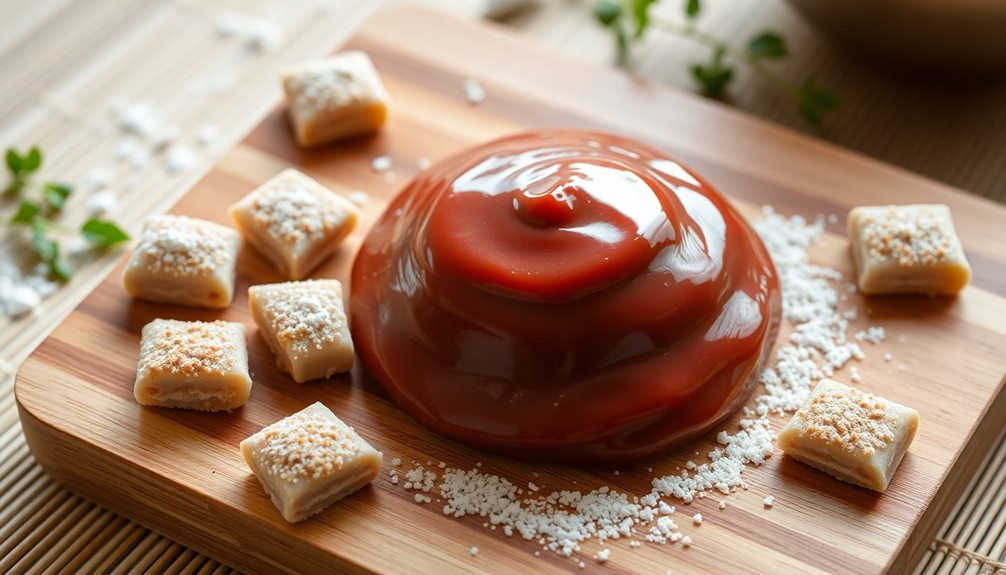
After you've pounded the rice into a smooth, chewy dough, it's time to incorporate the sweet red bean paste. This step is super fun and adds a delicious twist to your injeolmi!
First, take your sweet red bean paste and scoop out a generous amount. You can make it yourself or buy it from the store. Don't worry; either way, it'll taste great!
Next, divide your dough into equal pieces. Flatten one piece in your hand to create a little cup. Now, carefully place a spoonful of that yummy red bean paste right in the center.
Fold the edges of the dough over the paste and pinch them together. This will keep the sweet filling inside, making every bite a delightful surprise!
Repeat this for each piece of dough until you've used all the paste. It's like wrapping little gifts!
Once you're done, gently shape each piece into a round or oval form. This way, your injeolmi will look pretty and inviting.
You're almost there! Get ready for the next step, where you'll dust your chewy treats with a special flour. Yum!
Step 5. Dust With Soybean Flour
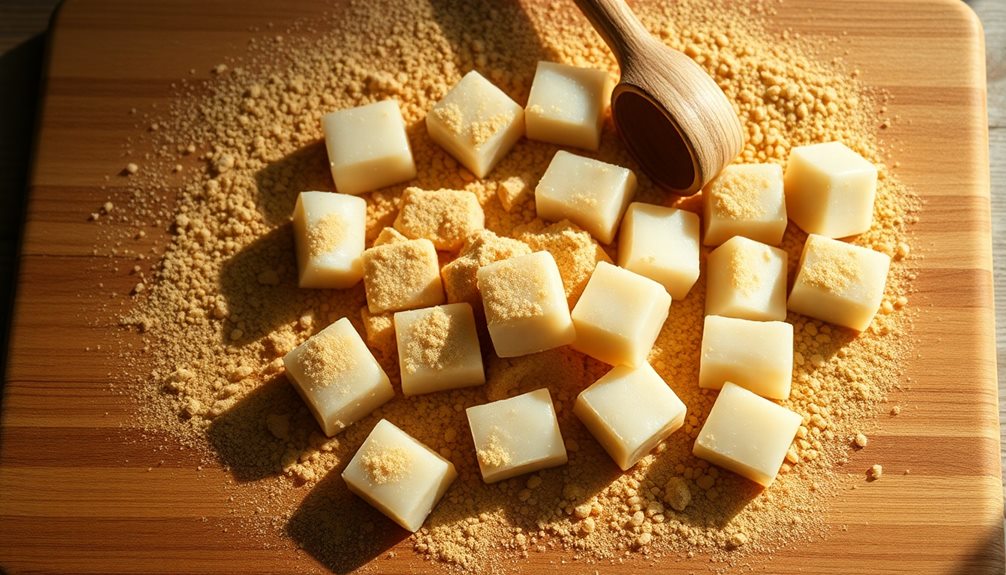
To give your injeolmi that perfect finish, you'll want to dust each piece with soybean flour. This step is super important because it adds a delicious nutty flavor and a nice texture that makes your rice cakes even more special. So, let's get started!
First, grab a plate or a shallow bowl and pour in some soybean flour. You can find this flour at Asian grocery stores, or you can make your own by grinding roasted soybeans. It's easy and fun!
Next, take each piece of your injeolmi and gently roll it in the soybean flour. Make sure every side gets coated well. This will create a lovely layer that keeps your rice cakes from sticking together.
After dusting, lay your injeolmi on a clean plate. You'll see how pretty they look, all coated in that golden flour!
Don't forget to taste a piece; it's chewy and nutty, just like you want. Finally, share your delicious injeolmi with family and friends, and watch their faces light up with joy! Enjoy your fantastic creation, and remember, injeolmi is always better when shared!
Final Thoughts
Injeolmi offers a delightful experience that captures the essence of Korean cuisine. This chewy rice cake isn't just a treat; it's a celebration of flavors and textures that makes every bite special.
When you take a piece of Injeolmi, you're tasting a tradition that's been cherished for generations!
Imagine the soft and chewy texture paired with the nutty flavor of soybean flour. It's a combination that dances on your taste buds!
Plus, it's fun to share with friends and family during special occasions or even just a cozy day at home.
Making Injeolmi can be a fun adventure, too. You can get creative with toppings or even try different fillings!
Whether you enjoy it plain or with a twist, each version remains true to its roots while inviting you to explore.
Frequently Asked Questions
Is Injeolmi Gluten-Free?
Yes, injeolmi is gluten-free since it's made from glutinous rice flour, which doesn't contain gluten. Enjoy it without worry if you're avoiding gluten, but always check for cross-contamination with other ingredients.
Can I Use Alternative Flours for Injeolmi?
Yes, you can use alternative flours for injeolmi. Try glutinous rice flour or other gluten-free options like almond or coconut flour. Just keep in mind that the texture and flavor might differ slightly from traditional recipes.
How Long Does Injeolmi Last?
Injeolmi typically lasts about three to five days when stored in an airtight container at room temperature. If you refrigerate it, it can last up to a week, but it may lose some texture.
Where Can I Buy Injeolmi?
You can buy injeolmi at Korean grocery stores, Asian markets, or specialty shops. Online options include retailers like Amazon or dedicated Korean food websites. Check local listings to find the nearest place to satisfy your cravings!
What Are Common Pairings With Injeolmi?
When enjoying injeolmi, you'll love pairing it with sweet red bean paste, honey, or even a sprinkle of powdered soybean flour. These combinations enhance its flavor and create a delightful, textured experience for your taste buds.
Ji-hoon is a skilled chef specializing in traditional and modern Korean cuisine. From savory bulgogi and kimchi to hearty stews and sizzling bibimbap, Ji-hoon’s recipes bring Korea’s bold, spicy, and umami-rich flavors to your kitchen. He focuses on authentic techniques and fresh ingredients that make Korean food so vibrant and flavorful.
-

 Southern Comfort Food1 month ago
Southern Comfort Food1 month agoCheese Straws
-

 Brazilian Cuisine1 month ago
Brazilian Cuisine1 month agoCaldeirada
-

 Southern Comfort Food1 month ago
Southern Comfort Food1 month agoCreamed Corn
-

 Brazilian Cuisine1 month ago
Brazilian Cuisine1 month agoChicken in Brown Sauce
-

 Brazilian Cuisine1 month ago
Brazilian Cuisine1 month agoTacacá
-

 Southern Comfort Food1 month ago
Southern Comfort Food1 month agoSquash Casserole
-

 Southern Comfort Food1 month ago
Southern Comfort Food1 month agoChocolate Gravy
-

 African Cuisine1 month ago
African Cuisine1 month agoPoulet DG (Cameroon)


